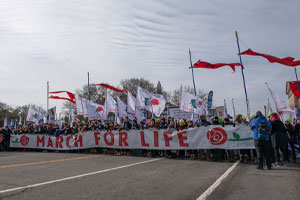
Despite the overturning of Roe v. Wade, the annual March for Life will take place on January 20 in Washington, D.C., on the 50th anniversary of the infamous 1973 Supreme Court decision. Many inveterate pro-lifers have trudged up to the Supreme Court for decades and feel that now is not the time to rest upon laurels but press the attack and keep marching.
However, moderate voices say that the annual event is no longer needed since the battle has shifted to the states. Others, who are on the Catholic left and have never liked the March, are only too happy to call it off to concentrate on “social justice” issues, which they deem to be more important. Feminists would be glad to see the disappearance of pro-life crowds full of women participants of all ages.
They all hate the March for Life. Some might tolerate a positive mention of “life.” However, what they hate most is the word “march,” and they hate it for three reasons.
A March Is a Forward Movement
First, a march signifies a forward movement in sync with others. Pro-abortion forces can deal with an unfocused and fragmented movement. However, the word “march” contains the notion of strength being united and directed toward a given goal.
Over the millennia, military men developed marches to help troops move to where they were needed. The use of coordinated action and rhythm creates dynamism and momentum. The individual overcomes weaknesses and draws strength from the collective action. The soldier knows he is part of something greater than himself.
Over the decades, the March for Life has served the purpose of uniting the movement and making all parties feel they are part of a huge single thrust engaged in the battle for the culture. Each pro-lifer becomes part of something greater, moving in sync toward the year’s new battles.
Help Remove Jesus Bath Mat on Amazon
The sight of hundreds of thousands marching forward every year in Washington cannot fail to strike fear in pro-abortion advocates. The march is much more than a rally or protest. It is a youthful force set in motion that creates the impression of invincibility. That is why the left hates it and why pro-lifers must keep marching.
A March Is an Energetic Movement
The March for Life is an energetic forward movement that instills a sense of purpose and militancy. The March makes the pro-life struggle more than just a discussion or debate. It is a passionate battle for the soul of America. It involves an intensity of action like that of a soldier, albeit on the cultural battlefield. It calls for organization, adaptability and cunning against an enemy with enormous resources and power.
Thus, the march incorporates the sense of a true battle calling for sacrifice and resolve. Every year, the March for Life requires great dedication as people come from all over the country to unite. The March must fight against a hostile establishment and media that carefully watches (yet underreports) its every move. The other side must admit that in its fifty-year history, the March has always been peaceful and legal, and its millions of participants have never caused any incidents of violence.
The event is an occasion to energize pro-lifers and fuse them together with a singular purpose. The overwhelming numbers give a sense of the movement’s strength year after year. The other side has nothing comparable.
The March Represents a Noble and Religious Cause
Finally, people hate the March for Life because it attaches the movement to a noble cause. Throughout history, marches often represent movements pursuing lofty purposes. This national event binds all who hold life precious to the highest of causes.
Satanic Christ Porn-blasphemy at Walmart — Sign Petition
More than just the lives of unborn babies, people gather to defend the underlying moral principles and, above all, God’s cause. The march is full of religious symbols, prayers and petitions. The multitudes who march are those who grieve for the sins of the nation. Their participation is a prayer to the Most High, imploring His intervention.
Thus, participants at the event sense the Divine Grace and presence that encourages them to continue marching, despite all odds. There is no other way to explain the persistence and tenacity of the pro-life movement save by this Divine action.
The left also senses and fears this action, which is so well manifested at the March.
The Act of Marching Is Symbolic
In considering their future participation in the March for Life, leaders of pro-life organizations and groups do well to consider the political aspects surrounding the issue. However, much more important is the symbolic act of marching that has proven so beneficial to uniting pro-lifers nationwide by its forward dynamism, its energizing effect and its attachment to a noble cause. They can also measure the March’s effectiveness by the hatred it provokes among pro-abortionists.
How Panera’s Socialist Bread Ruined Company
Indeed, the movement must never abandon this vibrant symbol of the pro-life cause. It must resist calls from moderates advocating a change in focus. It was disappointing but hardly surprising that Washington’s liberal Cardinal Wilton Gregory canceled the Mass and youth rally usually held before the March.
The movement must take this struggle against procured abortion to the end. March for Life President Jeanne Mancini is on target when encouraging pro-life Americans to “fearlessly continue marching.”
“We will continue to courageously and joyfully march until the grave injustice of abortion is unthinkable and every life is valued and protected,” she added.
After Dobbs, a battle that was won, pro-lifers must keep marching and press the attack. Final victory in the culture war depends upon it.


